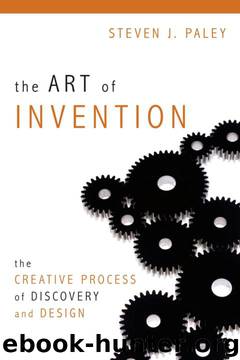The Art of Invention: The Creative Process of Discovery and Design by Steven J. Paley

Author:Steven J. Paley
Language: eng
Format: mobi
Published: 2010-12-01T09:06:00+00:00
Chapter 6
CLC000CC
THE MANY FACETS OF ELEGANCE
he word elegant is often defined as "stylish and graceful." We think of this meaning of elegance in terms of design, fashion, or architecture. We imagine elegance as something that is so "right," it brings its surroundings to a new state of heightened grace. The Alamillo Bridge in Spain is an example of the classic definition of elegance.
Figure 6.1: The Alamillo Bridge in Seville, Spain, designed by Santiago Calatrava. Photo from iStockphoto.
I am going to discuss another way of describing elegance as it applies to invention. I look at elegance as doing the most with the least. Elegance goes hand in hand with simplicity. An elegant invention is one that exploits simplicity to gain abundance, and this can be done in several ways. In the first part of this chapter, we will focus on elegance through ingenious simplicity. An invention can be simple but not necessarily elegant. However, most elegant inventions provide a profoundly simple yet very effective solution to a problem. Often the ingenuity of these inventions involves breaking through an existing paradigm and seeing the problem in a new way.
A second way of looking at doing the most with the least is to focus on the "most" part of the statement. Some inventions are so fundamental that they can be used in a multitude of different ways-often ways that were never imagined by the inventor or discoverer. I describe these as core inventions, and they often serve as the building blocks for future inventions. Many of these inventions are also ingeniously simple. Their elegance is shown by how many uses they have beyond their creator's original intent.
A third type of invention that does the most with the least is one that can modify its form, content, or behavior in response to its outside environment. These are inventions that do the "most" by changing themselves or their actions based on how they are used. Inventions of this sort fall into two broad categories: those that react or change behavior in a predictable way, and those that change in a manner impossible to predict. Predictable inventions change by adapting themselves in a foreseeable way to external conditions. Think of a spring applying a gradually greater opposing force as it is stretched. Unpredictable inventions actually grow and become something new as they are used. A prime example is the evolving World Wide Web with its proliferation of new sites.
In this chapter we will examine the many forms of elegance through example. We will start with inventions that highlight ingeniously simple solutions to problems, then we will move to fundamental or core inventions that have multiple and flexible uses. Next we will shift gears a little and look at inventions that have the ability to automatically regulate their responses based on their innate properties. Finally, we will examine inven tions that can change and actually grow during their use. Each category of invention represents a different facet of elegance.
INGENIOUS SIMPLICITY: THE MOST FROM THE LEAST
What is ingenious simplicity?
In a nutshell, it is figuring out how to get the most from the least.
Download
This site does not store any files on its server. We only index and link to content provided by other sites. Please contact the content providers to delete copyright contents if any and email us, we'll remove relevant links or contents immediately.
| Automotive | Engineering |
| Transportation |
Whiskies Galore by Ian Buxton(41867)
Introduction to Aircraft Design (Cambridge Aerospace Series) by John P. Fielding(33064)
Small Unmanned Fixed-wing Aircraft Design by Andrew J. Keane Andras Sobester James P. Scanlan & András Sóbester & James P. Scanlan(32743)
Craft Beer for the Homebrewer by Michael Agnew(18140)
Turbulence by E. J. Noyes(7935)
The Complete Stick Figure Physics Tutorials by Allen Sarah(7307)
Kaplan MCAT General Chemistry Review by Kaplan(6866)
The Thirst by Nesbo Jo(6826)
Bad Blood by John Carreyrou(6543)
Modelling of Convective Heat and Mass Transfer in Rotating Flows by Igor V. Shevchuk(6391)
Learning SQL by Alan Beaulieu(6208)
Weapons of Math Destruction by Cathy O'Neil(6139)
Man-made Catastrophes and Risk Information Concealment by Dmitry Chernov & Didier Sornette(5921)
Digital Minimalism by Cal Newport;(5661)
Life 3.0: Being Human in the Age of Artificial Intelligence by Tegmark Max(5474)
iGen by Jean M. Twenge(5366)
Secrets of Antigravity Propulsion: Tesla, UFOs, and Classified Aerospace Technology by Ph.D. Paul A. Laviolette(5309)
Design of Trajectory Optimization Approach for Space Maneuver Vehicle Skip Entry Problems by Runqi Chai & Al Savvaris & Antonios Tsourdos & Senchun Chai(5011)
Electronic Devices & Circuits by Jacob Millman & Christos C. Halkias(4907)
